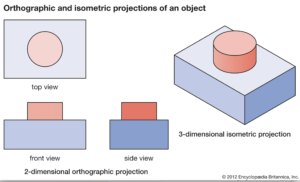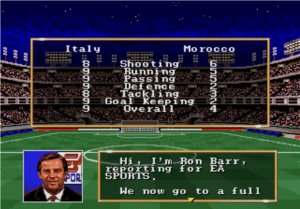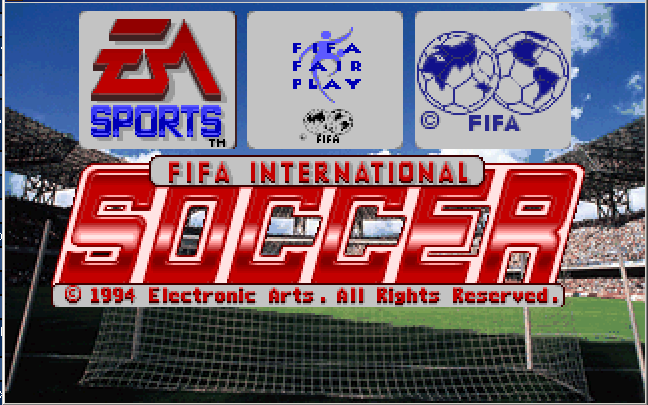FIFA International Soccer is a football (soccer) simulation videogame, and the first game in the now enormous FIFA franchise. It was released for the holiday season in December 1993 on the Sega Genesis console, and was also ported to many other systems in 1994 due to its great popularity. So, why was it popular? And how significant was it in the FIFA franchise, now the best-selling sports video game franchise in the world, with over 325 million copies sold as of 2021?
One aspect of FIFA International Soccer which placed it miles ahead of its competition at the time was the way it presented the soccer pitch, and used its space, that being through an isometric view. An isometric view is a two-dimensional representation of a three-dimensional object, aligned to three axes (Study.com, 2022). Soccer-associated videogames prior to 1993 did not incorporate this perspective, such as Sensible Soccer (Sensible Software, 1992), which instead used a ‘birds-eye’ view or Kick Off (Anco Software, 1989) which used a ‘top-down’ view. FIFA International Soccer’s isometric view creates a pseudo-3D effect, giving more dimensionality to the game, which can be argued as making the game more realistic.

Comparison of different ‘views’ (Encyclopaedia Britannica Inc., 2012)

Isometric-view in FIFA International Soccer
I believe that this is what drove the game’s popularity, as people wanted to feel as though they were playing in, or watching, a soccer game. As this was a more realistic simulator than anything else at the time, it would have induced these feelings more. Also, considering the competitive nature of soccer, and sports in general, I think that making the game more realistic enhanced its competitive aspect further as you felt that you were in the game or watching a game. In general, it was a casual game with competitive aspects, making it enjoyable to play both by yourself and against others, and hence it was so popular. Even the latest game in the series, FIFA 23 (EA Sports, 2022), features an isometric view style camera angle (granted, you can change the camera angles in a variety of ways), showing how significant the introduction of an isometric view was in the series.

FIFA International Soccer’s televisual presentation
Further, FIFA International Soccer also included a televisual presentation, where commentators would introduce matches and state some basic facts about each team. This was also a new feature, not present in competing soccer-associated videogames. Again, this mimicked what soccer games looked like when broadcast on television, further making the game a more realistic simulator.

Cover stars of FIFA 23: Mbappé (PSG) & Kerr (Chelsea)
However, a downside of FIFA International Soccer was that it only featured 49 teams, consisting of 48 national teams and a fictional “EA All Stars” team, and did not feature names or body designs of any real players. I believe that this limited how much of a simulator the game really was. The sequel, FIFA Soccer 95 (EA Canada, 1994) was the first to feature multiple teams from 7 different leagues, as well as national teams, and the third game in the series FIFA Soccer 96 (EA Sports, 1995) was the first to feature real player names and body designs. All FIFA games since have built on this concept and have recently introduced ultrarealistic face and body scans of real players, which pushes the boundaries of what a simulator can achieve.
Due to these reasons, I would suggest that FIFA 95 and 96 are more influential to the FIFA franchise, due to the massive emphasis on individual teams and players in modern FIFA games (and the soccer industry in general). This can be seen through ‘cover stars’ of FIFA, and FIFA Ambassadors, who are players chosen by EA Sports to promote the game. Speaking from personal experience, people tend to be very, very, passionate about the teams and players that they support, and when playing FIFA, tend to choose teams they support, and play with players that they like. This adds to the competitive aspect of FIFA, as well as the emotions and feelings it induces, so I argue that this is what FIFA International Soccer was missing as a simulator, and why other FIFA games were more influential in the series.
Unfortunately, Electronic Arts Inc. has recently lost the ‘FIFA’ branding rights due to a licensing disagreement, and hence FIFA 23 will be the last official game in the series. Although most of the player and team licensing remains, it will be interesting to see if there are any changes to the popularity of future soccer simulation videogames released by EA.
Bibliography:
Isometric-view. Study.com. Retrieved November 1, 2022, from https://study.com/learn/lesson/isometric-view.html
Isometric Projections. Encyclopaedia Britannica, Inc. (2012). In Britannica Student Encyclopedia (pp. 272).
FIFA (video game series). (2022, October 29). Wikipedia. Retrieved November 1, 2022, from https://en.wikipedia.org/wiki/FIFA_(video_game_series)


I enjoyed reading your review Filip. A theme I picked up on, and something you seem to suggest led to Fifa’s popularity, was its use of realism. You begin with the isometric view and the use of depth to create a realistic view, the introduction of commentators, the amount of teams, and end with a comment on the licensing of EA and the players they can incorporate.
For an RPG/ Sport game, do we think that realism is an effective form of portrayal partly because sports already have a fantastical narrative that surround them? By this, I mean that for game’s that deal with sport. There is an existing investment in sports players and their abilities; teams and players are given hype for their success in a way that separates them from normal reality. We discuss sports and athletes’ accolades in a removed way that implies they are living in a different reality, a fantasy for many. Because of the existing hype around sports and the ability of athletes, can sports games rely on realism in a way that other games cannot? It seems that because sports and players carry influence outside of a game, a game need only to tap into that existing influence to excite those that are influenced, and realism could be the most productive beginning way to do so.